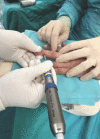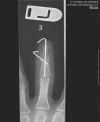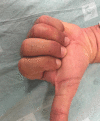Minimally Invasive Corrective Osteotomy (MICO) of the Hand a Novel Technique
- PMID: 38784896
- PMCID: PMC11111249
- DOI: 10.13107/jocr.2024.v14.i05.4448
Minimally Invasive Corrective Osteotomy (MICO) of the Hand a Novel Technique
Abstract
Introduction: Patients facing post-traumatic malunion or congenital hand differences often contend with functional and cosmetic issues. Traditional correction methods involve open osteotomy, marked by drawbacks like scarring, non-union risks, prolonged rehabilitation, and adhesions. We therefore introduce a novel minimally invasive technique called Minimally Invasive Corrective Osteotomy of the Hand (MICO), which can be performed under local anesthesia. MICO employs a low-speed, high-torque burr to address finger malunions and congenital anomalies.
Case report: A 49-year-old male patient, generally healthy and right hand dominant, presented with a post-traumatic left middle finger, middle phalanx malunion who underwent the MICO procedure, with a 1-year post-operative follow-up.
Conclusion: Our findings suggest that MICO offers a straightforward, reproducible, and delicate solution for correcting hand malunions and congenital finger deformities, potentially mitigating the well-established disadvantages and complications associated with the traditional open approach. Although early results of MICO are promising, a larger case series is needed to evaluate the superiority of this technique compared with current open corrective osteotomy methods.Level of Evidence: IV.
Keywords: Osteotomy; finger deformity; minimal invasive surgery.
Copyright: © Indian Orthopaedic Research Group.
Conflict of interest statement
Conflict of Interest: Nil
Figures





References
-
- Gollamudi S, Jones WA. Corrective osteotomy of malunited fractures of phalanges and metacarpals. J Hand Surg Br. 2000;25:439–41. - PubMed
-
- Lee SG, Jupiter JB. Phalangeal and metacarpal fractures of the hand. Hand Clin. 2000;16:323–32. vii. - PubMed
-
- Weckesser EC. Rotational osteotomy of the metacarpal for overlapping fingers. J Bone Joint Surg Am. 1965;47:751–6. - PubMed
-
- Botelheiro JC. Overlapping of fingers due to malunion of a phalanx corrected by a metacarpal rotational osteotomy--report of two cases. J Hand Surg Br. 1985;10:389–90. - PubMed
-
- van der Lei B, de Jonge J, Robinson PH, Klasen HJ. Correction osteotomies of phalanges and metacarpals for rotational and angular Malunion:A long-term follow-up and a review of the literature. J Trauma. 1993;35:902–8. - PubMed
Publication types
LinkOut - more resources
Full Text Sources
